Oregon Football Offensive Preview
If there's one thing that's clear about this offense, it's that Mario Cristobal and Oregon love blocks.
I’m going to be honest, it gets a little bit harder each week to stay optimistic here. I’ll write about how our upcoming opponent is one of the worst in the conference, only for them to end up smashing Cal in embarrassing fashion, forcing me to confront the uncomfortable truth that Cal is actually the one playing like one of the worst teams in the conference. Still, this game is nowhere near as hopeless as it may look on first glance. Poll rankings are relatively meaningless so far in this season of chaos, but I don’t believe Oregon is playing like one of the best teams in the country. Even if they were, I’d like to point out that before Oregon won the Pac-12 Championship last year, they lost to Cal. Further, Oregon has suffered a number of injuries to key players, the names of whom I’m sure you’ll hear if Cal pulls the upset. So this game isn’t anywhere near as hopeless as the NegaBears may lead you to believe.
Under Coach Mario Cristobal—a former offensive tackle for two-time National Champions at the University of Miami—the offensive line has been the clear strength of this team. Oregon runs a sort of power spread offense; a spread offense with roots in the power run game. This isn’t the Oregon offense led by NFL star Justin Herbert, predicated on beating teams through the air; it’s an offense that uses the pass as an extension of their run game. There’s a lot of power blocking schemes, RPOs, zone reads, screens, and quick passes. Blocks are what win the game for Oregon.
Quarterback
The Ducks are led by the grad transfer quarterback from Boston College, Anthony Brown. Although I believe that last year’s freshman starting QB Tyler Shough (now at Texas Tech) can develop into a great passer, the experienced Brown is leading the Ducks for his ability to run (literally) the offense. I took a number of Brown highlights, and they’re pretty much all on the ground. In each of these clips, try to take a look at the blocks being set.
Anthony Brown is a great athlete and clear dual-threat QB. Here he is on a designed quarterback run:
Here, Brown runs the option with RB Travis Dye, and looks more like a running back himself:
Even when given a free play on the offsides, he opted to take the easy yards running the ball when he saw green grass ahead of him:
Oregon will run a ton of RPOs and zone-read plays. In the next play, Brown keeps it himself and lets his blockers—including the relatively undersized RB Travis Dye and WR Jaylon Redd coming across on the jet sweep—seal the edge for the touchdown run:
What’s more, Brown’s not the type of quarterback to shy away from contact:
It should be clear at this point that the quarterback is an important part of the run game— even if Brown isn’t putting up a huge number of yards, even the threat of the run can help open things up on offense.
I wanted to include some passes here, but the vast majority of his throws just aren’t that notable; easy checkdowns, etc. Despite being a ~4 year starter, I wasn’t terribly impressed with his reads in the passing game. Here Brown feels pressure, and just assumes his hot route will be open— he doesn’t even see the linebacker sitting there:
You don’t see a lot of downfield passing from Brown, as Brown struggled to hit the deep shot even against weaker competition:
If you’re checking box scores and stat sheets, it’s probably safe to assume that those big plays came mostly as a result of yards after the catch (and you can see a few examples down in the receiver section of this article).
That’s not to say that Brown absolutely can’t throw the ball, it’s just probably not how Oregon will attack on offense. Here Brown makes a great throw under pressure:
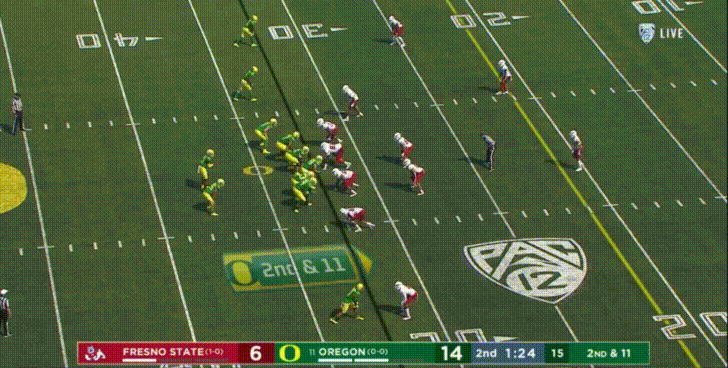
With the way Cal has played this season, don’t be surprised if pretty much everything I said in this section turns out to be wrong and Anthony Brown torches Cal for 400 passing yards or something. I don’t even know anymore.
Offensive line
I don’t usually put an offensive line section in these offensive articles, but that’s because I usually don’t take offensive line highlights. I had to make an exception for Oregon’s offensive line, though.
You’ll see this sort of play from Oregon often: check out the offensive lineman sprinting down the field to set the block for his running back:
I’m sorry, but there is simply no universe in which a defensive back is going to beat a block thrown by a 300+ lb. offensive lineman sprinting right at him. He is a mere speed bump on the run to the endzone.
The following is the sort of play you see from Oregon all the time. Here they are against a very talented Ohio State team clearing an enormous hole for CJ Verdell to run through:
Considering how thin Cal is at the defensive line, this doesn’t give me a ton of hope. However, this is a relatively young offensive line for Oregon, as they lost most of their starters from the 2020 Rose Bowl-winning team to the NFL. So they’re still pretty good, but definitely not unstoppable (cf. Stanford).
Running back
I find Oregon’s running backs the hardest to evaluate simply because of how often they’re running through ginormous holes opened up by the offensive line. Oregon has been led by the 1-2 punch of running backs CJ Verdell and Travis Dye, but they just lost Verdell for the season to injury. Verdell and Dye made a great power back/scatback tandem, but with Verdell out, they will be looking to one of their freshmen running backs—likely Trey Benson or Byron Cardwell—to step up in Verdell’s place. None of the freshmen running backs have received any meaningful carries, so I don’t really have any insight here. So let’s instead take a look at the other known quantity, Travis Dye.
In a few words: fast, shifty, elusive. I like Dye as a runner (besides the fact he had his breakout game in their 2018 win against us). Despite being a bit undersized, he runs with a low center of gravity, and often picks up a surprising number of yards after contact. Besides the obvious speed, he’s got great vision:
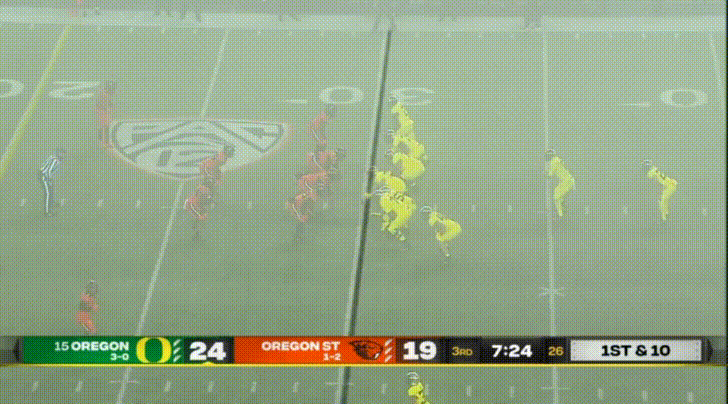
And as already mentioned, he’s quite shifty:
Additionally, Dye is a viable receiving threat out of the backfield:
The main drawback for Travis Dye is that he doesn’t have the size to be an every-down back for Oregon, and so they will need someone else to step up to handle that load.
Receivers
Because blocking has been the theme of this article, I figured I’d open with a block by two-way player, tight end/outside linebacker/former defensive end DJ Johnson. DJ Johnson played a crucial role in a number of big plays for Oregon in their victory over Ohio State. Watch the tight end lined up at the bottom of the screen:
DJ Johnson is more of a block-first, catch-second type of guy, but he has caught some nice contested catches as well.
Oregon has a mix of both very experienced—e.g. Johnny Johnson III and Jaylon Redd are guys who played with Justin Herbert—and very young receivers, including a number of true freshmen and Covid-era freshmen. (As a brief aside, I feel like there needs to be a word for this— it’s weird to say something like “sophomore Devon Williams,” when Devon Williams is actually playing in his 4th season).
Oregon has spread the ball out amongst their receivers, so there’s not much point focusing in too much on any one receiver: Oregon’s 8 passing TDs have been split amongst 7 players, their 77 receptions split amongst 16 players, with only Johnny Johnson III logging more than 10 catches (he has 11 in 5 games so far this season).
Johnny Johnson III is technically their leading receiver, and he’s been a reliable target for years now:

As mentioned previously, a big part of Oregon’s passing offense is yards after the catch:
Oregon’s most exciting and explosive playmaker is Mycah Pittman (the younger brother of former USC/now-Indianapolis Colts WR Michael Pittman Jr.), and in my opinion, he’s being criminally under-utilized. Pittman is fast, shifty, and often gets himself wide open after beating a corner. Did I mention he also has fantastic hands?:
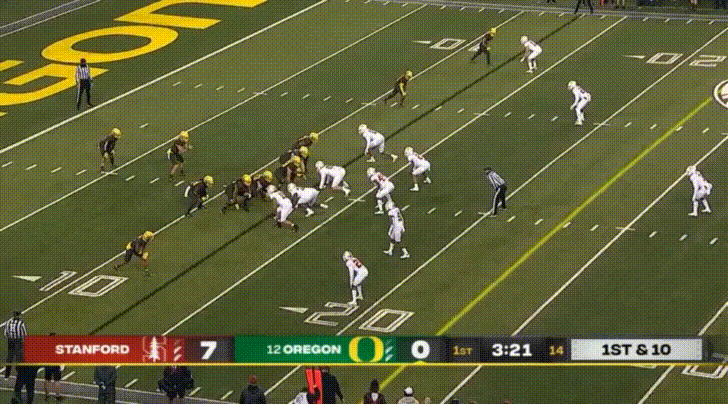
And here’s yet another big play after the catch by an Oregon receiver:
Jaylon Redd is another speedy (and smaller) receiver, the one Oregon likes to give the ball to on the jet sweep. Here he is picking up a ton of yards after the catch as well:
I’m also a fan of Devon Williams as a big-body receiver, but he hasn’t really been seen much this year. I didn’t want to plagiarize too much of my article from last year, so if you want to see what I think of him, you can always check out last year’s article.
Conclusion
This game is likely going to come down to how well Cal can stop the run and force Oregon to try to beat them through the air. How optimistic are you guys that Cal’s front-7 will be able to stop (or at least slow) Oregon?


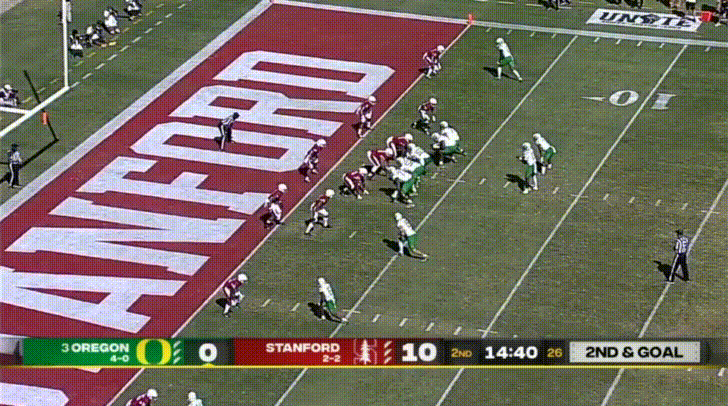
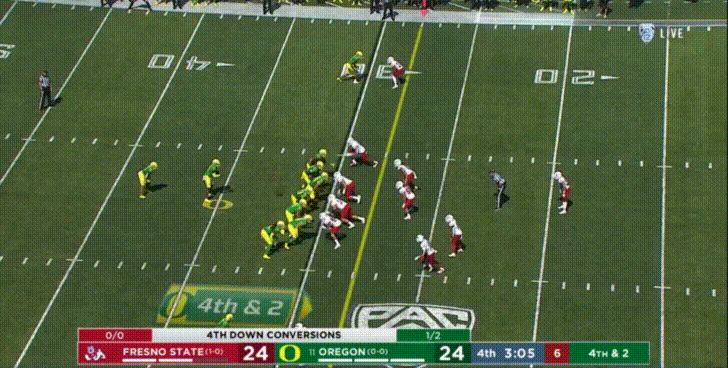

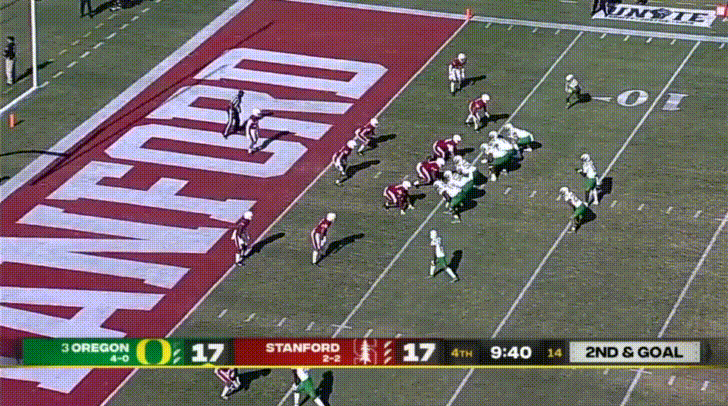
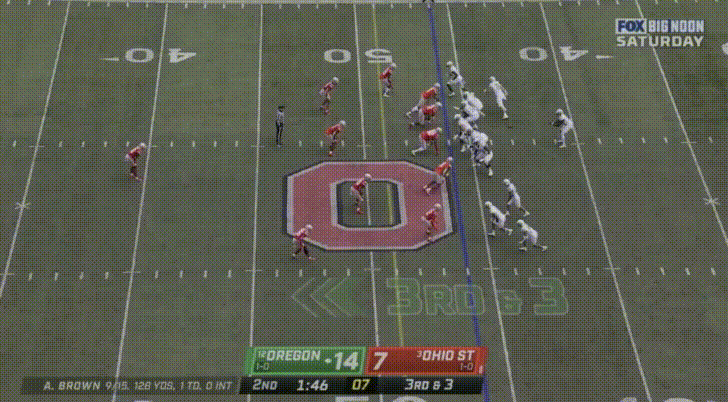
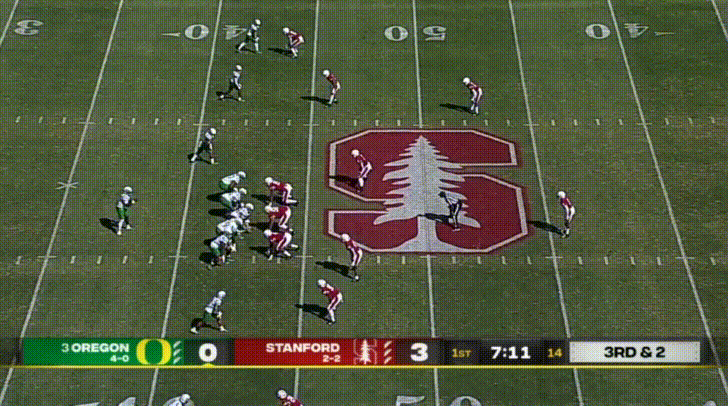
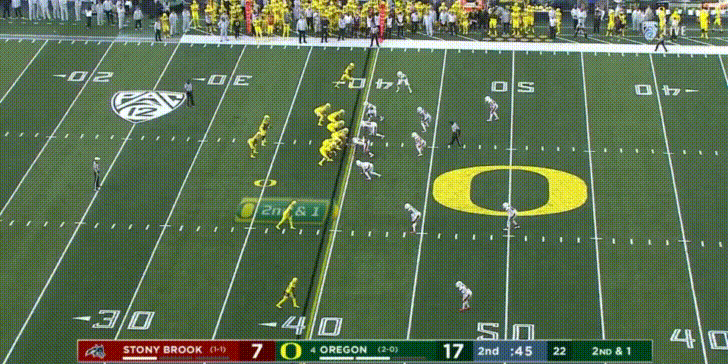
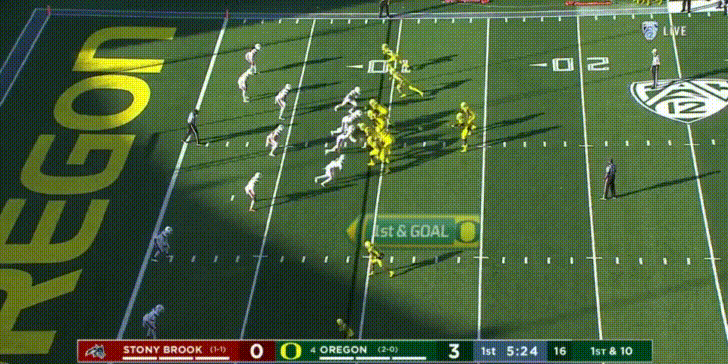

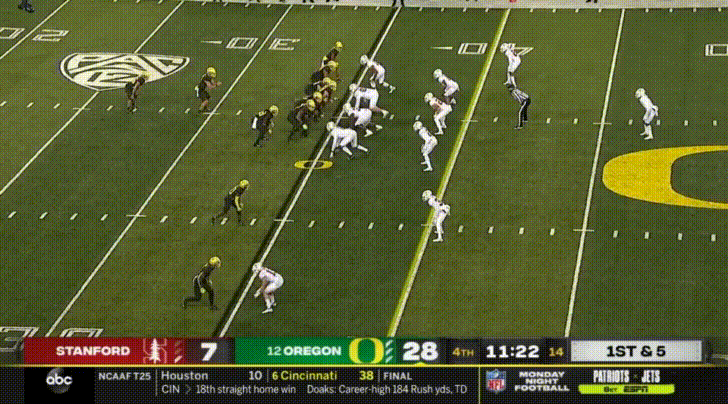

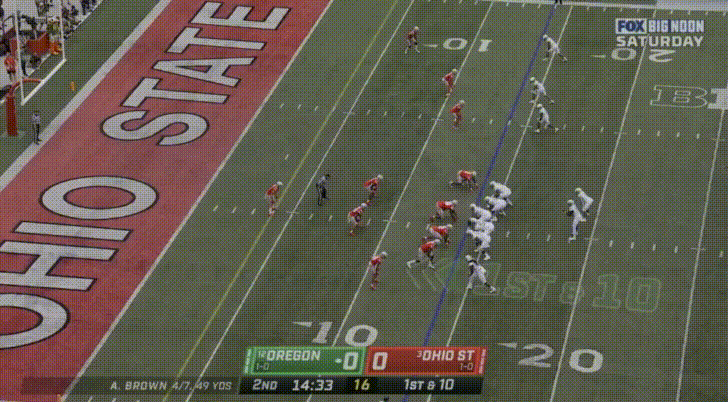
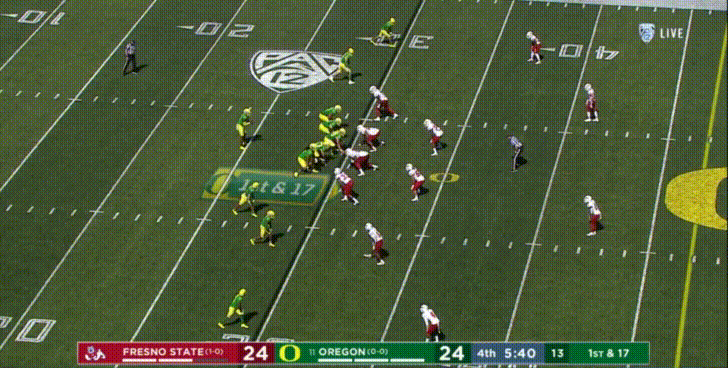

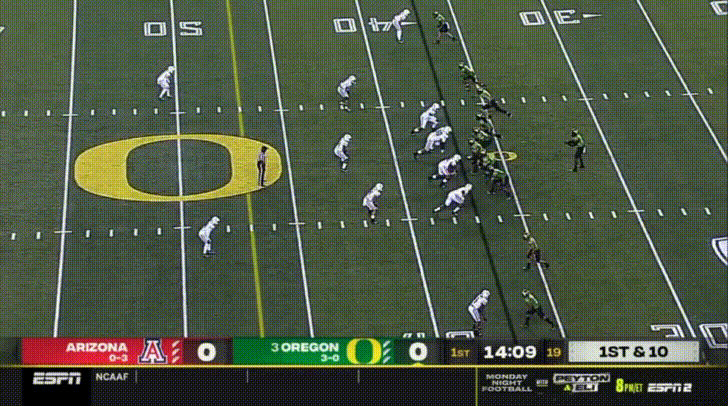
Christopher, you did a lot of work, and made some good, not obvious to me, notes regarding Oregon's blocking. They look smash-mouth and disciplined. Oh Boy what an upset this will be! GO BEARS!
Oregon fan here and long time reader (RIP CGB). Excellent preview of the offense. Just wanted to add more depth to what Christopher has mentioned.
The offense has been frustrating for fans this season given the amount of talent and versatility at WR. As mentioned, Brown hasn't been terribly accurate and his confidence as a passer reached a season-low during the Stanford loss as he attempted 0 passes downfield. The TEs/WRs are great and extremely talented. Fans believe this is the deepest group of pass catchers Oregon has ever had and I agree. Given the lack of productivity Brown has provided as a passer, fans/media have speculated all bye week that former 4/5 star recruit Ty Thompson should get the start. Cristobal has publicly said Brown will be the QB though. Fans were displeased at the vote of confidence to say the least. We'll see...
RBs have been awesome and missing Verdell will be a huge blow. Cristobal loves to pound the RB up the gut for 2-4 yards on standard downs with the intention of those body blows resulting in big gains in the second half. OL has been up and down. Talent is there for sure but they're still hitting their stride and have yet to play to their potential, Ohio St. game notwithstanding. With Joe Moorhead potentially back from his mystery illness and set to call plays Friday night, I expect the gameplan to heavily feature TEs (see Ohio State game) with some deep shots from Brown just to try and get his confidence back up again.